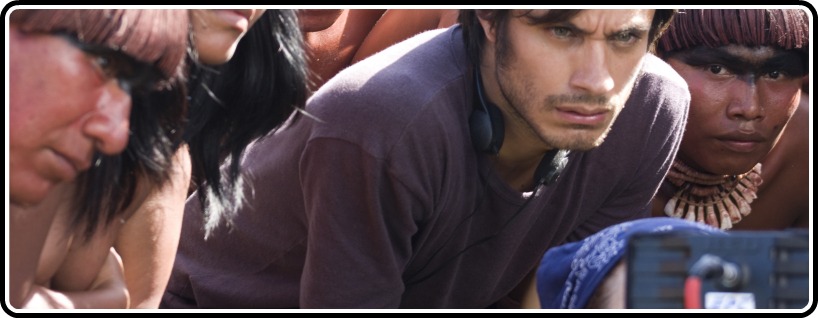The Spanish film Even the Rain begins with an open casting call. Bolivian locals have lined up around the block for the chance to audition to be extras in a production of a new movie about Christopher Columbus. This historical epic’s director, Sebastian (Gael GarcÃa Bernal), wants the film to be authentic, so he’s invited the area’s indigenous people so he can pick his cast from their ranks. Like many Spanish conquerors before him, however, he is overwhelmed by just how many indigenous people there actually are. One in particular, Daniel (Juan Carlos Aduviri), loudly protests when the crew tells them he and his daughter (Milena Soliz) will not be seen. They promised everyone that they’d have a shot. Admiring his pluck, Sebastian casts Daniel as Hatuey, a man who stood up against Columbus and foreign rule.
As soon as this decision is made, a helicopter appears on the horizon. It is hauling a massive wooden cross, a prop for the climactic scene in Sebastian’s movie. Film fans will immediately think of the helicoptered Virgin Mary from Fellini’s La dolce vita, a reference screenwriter Paul Laverty (Looking for Eric) and director IcÃar BollaÃn (Mataharis, Take My Eyes) must be aware of. Even the Rain has a touch of Fellini to it, at least in how it peels back the curtain on show business. Though, the production they are depicting is less reminiscent of the maestro than it is Werner Herzog. That cross being flown over the Andes might as well be a massive boat for all the good it’s going to do them in the trying days ahead.
Even the Rain is a deftly realized feature film. It encompasses many elements and multiple rich storylines, but it never feels burdened by its own ambition or overwhelmed by any particular puzzle piece. Sebastian’s pragmatic producer, Costa (played by Luis Tosar, who was the ‘Violin’ in Jarmusch’s The Limits of Control), warns his harried director that Daniel will be trouble, and he’s right. Daniel is a political organizer who is rallying his neighbors against the government and multinational corporations trying to steal their water rights. Life imitated the art that is already imitating life: the actor playing Hatuey is his assigned character, he is Hatuey. Likewise, the production crew and the actors are as conflicted and flawed as the men they are resurrecting. Sebastian’s script is intended to show the human side of colonial and evangelical stridency, but even his heroes have embarrassing skeletons leaving a nagging rattle in their historical closets.
BollaÃn shows considerable narrative agility as she jumps between her various stories. We see the film crew on the set and behind the scenes, and we also see them partying and rubbing elbows with local dignitaries. At the same time, we see Daniel and his people clash with police. There are accusations of ghetto tourism when some of the actors feel proud of themselves for learning the Indian word for ‘water’ without really giving a thought to what water means to the poverty-stricken people teaching them the word. Worse, the cheap cost of labor that makes shooting in South America possible is perhaps more unctuous than the exploitation of the past. Modern sensibilities being what they are, these guys should know better. Philosophical and moral parallels are drawn between now and then via the dailies from Sebastian’s shoot. It’s a trick that could have been heavy handed, but it works oh so well. Other political dramas could do well to learn from Avery and BollaÃn’s example. Even the Rain manages to say something about world problems without sacrificing the integrity of its narrative, hitting the audience over the head, or committing the most grievous of sins, giving moviegoers a false feeling of ‘being a part of the solution’ by suggesting that they are better people just for sitting down and having watched the damned thing. (Yes, I know, you saw Crash. You could never be a racist.)
For anyone who likes character-driven drama, Even the Rain is going to be right up your alley. Part of why it works so well is that all of the characters have ethical standards that are liquid. At different times, all of them make the wrong choice. A couple of them also get a chance to redeem themselves. Neither move is made with any fingerpointing, however. Costa, who has kicked most fiercely against being involved in any way that doesn’t advance the production, even gets to be a hero. BollaÃn knows she doesn’t need to underscore his actions, she has faith in the material and Tosar’s incendiary performance. She knows letting them both follow their own course will have more impact than, say, having Costa run in slow-motion through the streets when everything hits the fan, backed by swells of music and the cheers of the hoi polloi. The final third of the film takes place during a violent clash between protesters and the army, yet we don’t see any direct confrontation. What Even the Rain shows instead is how these people either keep their head up and carry on, or how they duck down and get out of the fight. Every character must ask him or herself how far he or she will go. How much is too much?
Even the Rain plays the Portland International Film Festival on 2/24 and 2/26.




![Bergman Island (The Criterion Collection) [Blu-ray]](https://criterioncast.com/wp-content/uploads/2022/11/bergman-island-the-criterion-collection-blu-ray-400x496.jpg)
![This Is Not a Burial, It’s a Resurrection (The Criterion Collection) [Blu-ray]](https://criterioncast.com/wp-content/uploads/2022/11/this-is-not-a-burial-its-a-resurrection-the-criterion-collection-blu-ray-400x496.jpg)
![Lars von Trier's Europe Trilogy (The Criterion Collection) [The Element of Crime/Epidemic/Europa] [Blu-ray]](https://criterioncast.com/wp-content/uploads/2022/11/lars-von-triers-europe-trilogy-the-criterion-collection-the-element-of-400x496.jpg)
![Imitation of Life (The Criterion Collection) [Blu-ray]](https://criterioncast.com/wp-content/uploads/2022/11/imitation-of-life-the-criterion-collection-blu-ray-400x496.jpg)
![The Adventures of Baron Munchausen (The Criterion Collection) [4K UHD]](https://criterioncast.com/wp-content/uploads/2022/11/the-adventures-of-baron-munchausen-the-criterion-collection-4k-uhd-400x496.jpg)
![Cooley High [Criterion Collection] [Blu-ray] [1975]](https://criterioncast.com/wp-content/uploads/2022/11/cooley-high-criterion-collection-blu-ray-1975-400x496.jpg)
1 comment